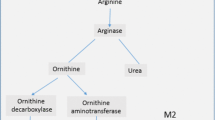Abstract
The macrophage is the characteristic cell type in chronic inflammatory reactions, in the rheumatoid synovium, as in other sites. When macrophages are activated, considerable synthesis of enzymes and other proteins occurs. Macrophages can be activated by (i) products of activated lymphocytes, (ii) immune complexes and (iii) the complement cleavage product C3b. Among the many consequences of macrophage activation are (i) secretion of hydrolytic enzymes, (ii) cleavage of C3 into C3a, which is cytolytic, and C3b, (iii) production of tissue thromboplastin, a powerful procoagulant, and (iv) formation of polyamine oxidase, which in the presence of appropriate substrates generates factors that lyse or limit the proliferation of tumour cells, lymphocytes and micro-organisms. The relevance of these observations to the pathogenesis of chronic inflammatory reactions is discussed.
Similar content being viewed by others
References
A.C. Allison andP. Davies,Mechanisms Underlying Chronic Inflammation, in:Future Trends in Inflammation, (Eds. G.P. Velo, D.A. Willoughby and J.P. Giroud; Piccin Medical Books, Padua, 1974), pp. 449–480.
M. Ziff,Pathophysiology of Rheumatoid Arthritis, Fed. Proc.32, 131–133 (1973).
J.P. Cole andJ. Brostoff,Intracellular Killing of Listeria monocytogenes by Activated Macrophages (Mackaness System) is Due to Antibiotic, Nature, Lond.256, 515–517 (1975).
P. Davies andA.C. Allison,Secretion of Macrophage Enzymes in Relation to the Pathogenesis of Chronic Inflammation, in:Immunobiology of the Macrophage (Ed. D.S. Nelson; Academic Press, New York, London, 1976), pp. 427–461.
H.U. Schorlemmer, J. Ferluga andA.C. Allison,Interactions of Macrophages and Complement Components in the Pathogenesis of Chronic Inflammation, in:Future Trends in Inflammation (Eds. D. Willoughby, G.P. Velo and J.P. Giroud; MTP Press, Lancaster, 1977), (in the press).
K.S. Warren andD.L. Boros,The Schistosome Egg Granuloma—a Form of Cell-Mediated Immunity, in:Mononuclear Phagocytes (Ed. R. van Furth; Blackwell, Oxford, 1975), pp. 1015–1028.
J.R. David andR.R. David,Cellular Hypersensitivity and Immunity. Inhibition of Macrophage Migration and the Lymphocyte Mediators, Progr. Allergy16, 300–449 (1972).
R.M. Pantalone andR.C. Page,Lymphokine-Induced Production and Release of Lysosomal Enzymes by Macrophages, Proc. Nat. Acad. Sci. U.S.A.72, 2091–2094 (1975).
L.M. Wahl, S.M. Wahl, S.E. Mergenhagen andG.R. Martin,Collagenase Production by Lymphokine-Activated Macrophages, Science187, 261–263 (1975).
J.-D. Vasalli andE. Reich,Macrophage Plasminogen Activator: Induction by Products of Activated Lymphoid Cells, J. exp. Med.145, 429–437 (1977).
W.F. Piessens, W.H. Churchill, Jr. andJ.R. David,Macrophages Activated in vitro with Leukocyte Mediators Kill Neoplastic but not Normal Cells, J. Immunol.114, 293–299 (1975).
W.G. Spector andW. Heesom,The Production of Granulomata by Antigen-Antibody Complexes, J. Path. Bact.98, 31–39 (1969).
H. Huber andM. Weiner,Binding of Immune Complexes to Human Macrophages: the Role of Membrane Receptor Sites, in:Activation of Macrophages (Eds. W.H. Wagner and H. Hahn; Excerpta Media, Amsterdam, 1974), pp. 54–61.
C.J. Cardella, P. Davies andA.C. Allison,Immune Complexes Induce Selective Release of Lysosomal Enzymes, Nature, Lond.247, 46–48 (1974).
R.C. Page, P. Davies andA.C. Allison,Participation of Mononuclear Phagocytes in Chronic Inflammatory Diseases, J. Rectic. Soc.15, 413–438 (1974).
H.U. Schorlemmer, D. Bitter-Suermann andA.C. Allison,Complement Activation by the Alternative Pathway and Macrophage Enzyme Secretion in the Pathogenesis of Chronic Inflammation, Immunology32, 929–940 (1977).
H.U. Schorlemmer andA.C. Allison,Effects of Activated Complement Components on Enzyme Secretion by Macrophages, Immunology31, 781–788 (1976).
J. Ferluga, H.U. Schorlemmer, L. Baptista andA.C. Allison,Production of the Complement Cleavage, C3a, by Activated Macrophages and its Tumorolytic Effects, Clin. exp. Immunol. (in press).
R.F.M. Lai A Fat andR. Van Furth,In vitro Synthesis of Some Complement Components (C1q, C3 and C4) by Lymphoid Tissues and Circulating Leucocytes In Man, Immunology28, 359–368 (1975).
C. Bentley, D. Bitter-Suermann, U. Hadding andV. Brade,In vitro Synthesis of Factor B of the Alternative Pathway of Complement Activation by Mouse Peritoneal Macrophages, Europ. J. Immunol.6, 393–398 (1976).
H. Prydz, A.C. Allison andH.U. Schorlemmer,A New Link between Complement Activation and Blood Coagulation, Nature, Lond. (in press).
T. Hovi, D. Mosher andA. Vaheri, Cultured Human Monocytes Synthesize and Secrete α2-Macroglobulin. J. exp. Med.145, 1580–1589 (1977).
T.J. Smith andR.R. Wagner,Rabbit Macrophage Interferons: 1. Conditions for Biosynthesis by Virus-Infected and Uninfected Cells, J. exp. Med.125, 559–577 (1967).
P. Bodel andH. Miller,Differences in Pyrogen Production by Mononuclear Phagocytes and by Fibroblasts or Hela Cells, J. exp. Med.145, 607–617 (1977).
F.W. Ruscetti andP.A. Chervenick,Release of Colony-Stimulating Factor from Monocytes by Endotoxin and Polyinosinic-Polycytidylic Acid, J. Lab. Clin. Med.83, 64–72 (1974).
P. Davies, R.J. Bonney, M. Dahlgren, P. Tulesi, J. Hume andF.H. Kuehl,Prostaglandin Synthesis by Activated Macrophage, in:Future trends in Inflammation (Eds. D.A. Willoughby, G.P. Velo and J.P. Giround; ASP Press, Lancaster) (in press).
L.M. Wahl, S.M. Wahl, S.E. Mergenhagen andG.R. Martin,Collagenase Production by Endotoxin-Activated Macrophages, Proc. Nat. Acad. Sci. U.S.A.71, 3598–3601 (1974).
T. Saldeen, C. Busch andL. Rammer,Trauma and Intravascular Coagulation, Acta Path. Microbiol. Scand. Section A78, 491 (1970).
R.P.A. Rivers, W.E. Hathaway andW.L. Weston,The Endotoxin-Induced Coagulant Activity of Human Monocytes. Brit. J. Haematol.30, 311–316 (1975).
H. Prydz andA.C. Allison,Tissue Thromboplastin Activity of Isolated Human Monocytes (submitted for publication).
E. Björklid, E. Storm andH. Prydz,The Protein Component of Human Brain Thromboplastin, Biochem. Biophys. Res. Comm.55, 969–976 (1973).
M. Hvatum, T. Hovig andH. Prydz,Studies on Tissue Thromboplastin-Electron Micrography, Thrombosis et Diathesis Haemorrhagica21, 223–231 (1969).
K.E. Giercksy, A-B. Otnaess, E. Björklid, andH. Prydz,A New Therapy in Post-Traumatic Intravascular Coagulation, Thombos. Haemostas. (Stuttgart)36, 641–644 (1976).
J. Ferluga, H.U. Schorlemmer, L. Baptista andA.C. Allison,Cytolytic Effects of the Complement Cleavage Product, C3a, Brit. J. Cancer34, 626–634 (1976).
H. Tabor andC.W. Tabor,Biosynthesis and Metabolism of 1,4-Diaminobutane, Spermine, Spermidine, and Related Amines, Adv. Enzymol.36, 203–268 (1972).
A.C. Allison, I.A. Clark andP. Davies,Cellular Interactions in Fibrogenesis, Ann. Rheum. Dis.36, (Suppl.), 8–13 (1977).
S.J. Leibovitch andR. Ross,The Role of the Macrophage in Wound Repair. A Study with Hydrocortisone and Antimacrophage Serum, Am. J. Pathol.78, 71–100 (1975).
S.J. Leibovitch andR. Ross,A Macrophage-Dependent Factor that Stimulates the Proliferation of Fibroblasts in vitro, J. Pathol.84, 501–513 (1976).
Author information
Authors and Affiliations
Rights and permissions
About this article
Cite this article
Allison, A.C., Ferluga, J., Prydz, H. et al. The role of macrophage activation in chronic inflammation. Agents and Actions 8, 27–35 (1978). https://doi.org/10.1007/BF01972398
Issue Date:
DOI: https://doi.org/10.1007/BF01972398




